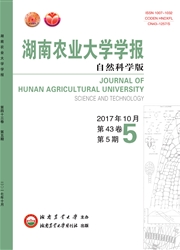

 中文摘要:
中文摘要:
选用50头体重相近的三元杂交断奶健康仔猪,随机分为5组:对照组全程饲喂玉米-豆粕型基础日粮;试验1、2、3、4组在试验第1天到第28天分别饲喂基础日粮+蜡样芽孢杆菌、鼠李糖乳杆菌和戊糖乳杆菌(质量比为1:1:1、1:2:1、2:1:2、1:1:2)的混合益生菌制剂,在第29天到第42天饲喂基础日粮。饲喂28d后计算各组仔猪13增重、料重比、腹泻率。结果表明:4个试验组仔猪的13增重均高于对照组,料重比均低于对照组,腹泻率均显著低于对照组;试验1、3组仔猪的日增重显著高于对照组,且试验1组仔猪的日增重又稍高于试验3组;试验1、3组仔猪的料重比显著低于对照组,而试验1组仔猪的料重比又稍低于试验3组;试验1组和3组仔猪的腹泻率相同,且低于试验2组和4组,表明4种比例混合的益生菌制剂均能促进仔猪生长,且以质量比1:1:1、2:1:2混合的益生菌制剂促进仔猪生长的效果较好;对试验1组和对照组仔猪在试验0、7、14、21、28、42d肠道内菌群的定量PCR结果表明,试验1组仔猪肠道内蜡样芽孢杆菌、鼠李糖乳杆菌数量在饲喂益生菌制剂期间呈现一致的变化趋势,即先上升后下降,再上升,而对照组3种菌的变化趋势不一致;在停喂益生菌制剂2周后,3种益生菌仍呈规律变化,表明饲喂益生菌制剂能够调节仔猪肠道相应菌群的生长;对仔猪肠道粪样菌群的16SrDNA的特异序列的进行变性梯度凝胶电泳及抠胶测序的结果表明,仔猪在饲喂益生菌制剂7d后,肠道蜡样芽孢杆菌、肠球菌、链球菌、双歧杆菌、戊糖乳杆菌、大肠杆菌、鼠李糖乳杆菌菌群数量均下降,到第28天时,各种菌群数量均上升,表明饲喂益生菌制剂不仅能调节仔猪肠道相应益生菌的生长,还能调节肠道肠球菌、链球菌、大肠杆菌与双歧杆菌的生长。
 英文摘要:
英文摘要:
Fifty weaned healthy piglets with similar weight were randomly assigned to five groups: control group fed with corn-soybean meal diets during all the process; test group 1, 2, 4 and 4 first fed with basal diet added with probiotics containing Bacillus cereus, Lactobacillus rhamnosus, and Lactobacillus pentosus mixed in ratio of 1 : 1 : I, 1 : 2 : 1, 2 : 1 : 2 and 1 : 1 : 2, respectively from the 1st to the 28th day of the experiment, then with basal diet from the 29th day to the 42nd day. Daily gain, feed/weight ratio, diarrhea rate were calculated after 28 days of feeding. The results showed that daily gain was higher, feed/weight ratio was lower and diarrhea rate was significantly lower in piglets of test groups compared to the control. Daily gain of piglets in test group 1 and 3 was significantly higher than that in the control and in test group 1 was slightly higher than in group 3. Feed/weight ratio of piglets in test group 1 and 3 was significantly lower than that in the control and in test group 1 was slightly lower than in group 3. Piglets in test group l and 3 showed the same diarrhea rate which was lower compared to test group 2 and 4. These results indicate probiotics with mixing ratio of 1 : 1 : 1 and 2 : 1 : 2 have better growth promoting effect for piglets. Quantitative PCR was applied on samples of test group 1 and control group collected after 0, 7, 14, 21, 28, 42 d from the beginning of the experiment, the results showed Bacillus cereus, Lactobacillus rhamnosus, and Lactobacillus pentosus in intestine of piglets in test group 1 exhibited the same growth tendency during feeding the probiotics, which increased and then decreased and increased again, while the 3 strains in intestine of piglets of control group didn't show such same tendency. The 3 strains still showed regular changes 2 weeks after ceased feeding the probiotics, indicating probiotics could regulate the growth of the correspond bacteria in intestine of the piglets. Denaturing gradient gel electrophoresis ?
 同期刊论文项目
同期刊论文项目
 同项目期刊论文
同项目期刊论文
 Oxidation of aromatic compounds and bioelectrocatalysis of peroxide by a novel white laccase from My
Oxidation of aromatic compounds and bioelectrocatalysis of peroxide by a novel white laccase from My Co3O4 nanoparticles as an efficient catalase mimic: Properties, mechanism and its electrocatalytic s
Co3O4 nanoparticles as an efficient catalase mimic: Properties, mechanism and its electrocatalytic s Induction of a white laccase from the deuteromycete Myrothecium verrucaria NF-05 and its potential i
Induction of a white laccase from the deuteromycete Myrothecium verrucaria NF-05 and its potential i Purification, characterization and decolorization of bilirubin oxidase from Myrothecium verrucaria 3
Purification, characterization and decolorization of bilirubin oxidase from Myrothecium verrucaria 3 Characterization and dye decolorization ability of an alkaline resistant and organic solvents tolera
Characterization and dye decolorization ability of an alkaline resistant and organic solvents tolera Polysaccharides from Phellinus linteus inhibit cell growth and invasion and induce apoptosis in HepG
Polysaccharides from Phellinus linteus inhibit cell growth and invasion and induce apoptosis in HepG Characterisation of a Novel White Laccase from the Deuteromycete Fungus Myrothecium verrucaria NF-05
Characterisation of a Novel White Laccase from the Deuteromycete Fungus Myrothecium verrucaria NF-05 期刊信息
期刊信息
